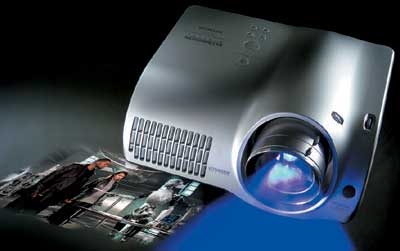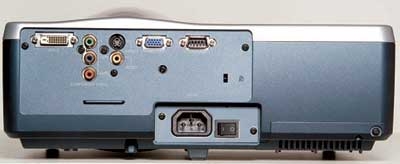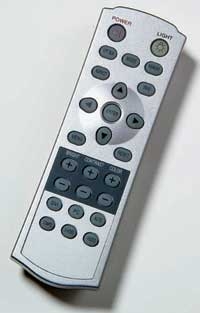Super-Size HDTV Page 5
Hitachi Uncompromising quality, sleek package
Hitachi is new to the home theater front-projector game, so it was with great interest that I unpacked its PJ-TX100. This $3,999 projector costs more than many of its neighbors in the high-def LCD world, but it also has many good things to recommend it. Among them is a ten-step motorized iris for optimizing image contrast and a customizable eight-step gamma control - a feature that, among other things, helps to enhance dark areas of the picture. As I've implied already, any help you can get in the LCD black-level department is very welcome. 
|
Every aspect of the PJ-TX100 is completely solid, from its detailed user manual to the construction of its silver, aerodynamic casing. With the Whisper option in its setup menu selected, fan noise was so low I barely noticed it. Pretty much any input jack you'd need is located around the back, including an RS-232 port for hooking it up to a control system from companies like AMX or Crestron.
The Hitachi 's remote control reminded me of the Panasonic's - small and a bit on the flimsy side yet functional. It has a backlit keypad and several buttons that let you directly control functions like input selection, iris control, and brightness, contrast, and color adjustments. There are also easy-to-find buttons for toggling through the projector's five picture presets and four user memories.
SETUP Once I had run through the rough details of setup, I started fine-tuning the PJ-TX100's picture with the many tools Hitachi provides. After selecting a gamma preset that looked good, I moved on to the ten-step iris adjustment to dial in the best possible black level - one that made dark areas in the picture look as realistic as possible. The Hitachi 's 6500K color-temperature preset turned out to be a bit off spec (see "in the lab" for details), so I created a custom preset that looked more accurate. 
 PICTURE QUALITY One sequence from I, Robot turned out to be an especially good test of the Hitachi 's capabilities. Del is chatting with an executive in a high-rise building whose large office has a dome-like grid of windows on one side. As they talked in the dark interior of the office, I could see plenty of shadow detail in the detective's black leather coat, the exec's dark gray pants, and the plush office furniture. And when they moved over to the lighter section near the windows, the dark parts of the picture retained pretty much the same level of shadow depth and detail. In both parts of this scene, the men's skin tones looked completely natural.
PICTURE QUALITY One sequence from I, Robot turned out to be an especially good test of the Hitachi 's capabilities. Del is chatting with an executive in a high-rise building whose large office has a dome-like grid of windows on one side. As they talked in the dark interior of the office, I could see plenty of shadow detail in the detective's black leather coat, the exec's dark gray pants, and the plush office furniture. And when they moved over to the lighter section near the windows, the dark parts of the picture retained pretty much the same level of shadow depth and detail. In both parts of this scene, the men's skin tones looked completely natural.
The Hitachi showed loads of picture detail when I switched over to HDTV. In the movie Seabiscuit on HBO HD, closeups revealed the fine texture of the actors' clothing and skin. And in a scene at a sunny racetrack, shadows were deep and rich, and the jockeys' garish uniforms came across in extremely vivid colors. I sometimes saw a slight screen-door effect at a viewing distance of 14 feet, but for the most part I barely noticed it.
Hitachi 's solid PJ-TX100 offers topnotch video performance, build quality, and features. You could certainly spend less on a projector and still get satisfying results, but from the standpoint of overall quality, this Hitachi projector looms large. PDF: Features Checklist PDF: In The Lab
Bottom Line Want to get an ultra-large HDTV picture for four grand or less? Right now, your only option is to buy an LCD front projector. As the models tested here demonstrate, the picture quality of LCD projectors has come a long way since their early days and now provides stiff competition for DLP. With its good looks and even better performance, the Sony is my top choice in this quartet. The Hitachi runs a close second, but only because the Sony looks cooler and costs less. Budget concerns? The Panasonic packs a powerful one-two punch of value and performance. And if maximum brightness is your overriding goal, go for the Epson. But no matter which model you ultimately choose, you'll be enjoying the best home-entertainment deal going.
- Log in or register to post comments




















































